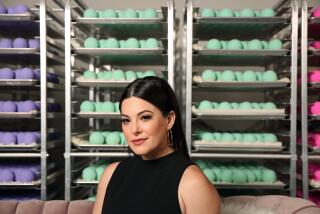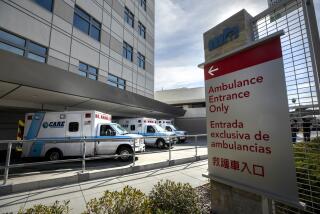Encouraging Vital Signs
- Share via
IRVINE — Michael Henson spends his life talking to heart doctors. He vacations with them. He watches them work. In an interview, the chief executive noted that he had recently “spent all day in a catheter lab, with my suit off, with greens on, watching cardiologists putting catheters in patients.”
Such attention to detail is one reason the young Irvine company he runs, CardioVascular Dynamics Inc., is experiencing sudden growth. Sales this year are expected to hit $8 million, double 1995’s results. The company, which had all of eight employees 15 months ago, is anticipating a payroll of 200 by year’s end.
The Irvine company might even break off from its Pleasanton-based parent, Endosonics Corp., this year and go public, although executives are tight-lipped about those plans.
Henson, who has run several biomedical start-up companies, talked extensively about the company’s obsession with product quality.
*
CardioVascular, which Henson and chief engineer Michael Crocker founded four years ago, makes lifesaving products--catheters for treating clogged arteries. And employees inspect every single product that goes out the door, instead of doing limited sampling that large health-care companies do, Henson said.
“We throw away [catheters] that other companies would sell,” he said, noting that products with just the slightest discoloration are rejected. A company that’s virtually unknown in its marketplace can’t afford a mistake.
A number of competitors, both large and small, also make catheters. But Henson and Crocker insist that their devices have unique features.
“This is hot stuff,” Crocker said as he demonstrated the company’s prized product, a patented catheter with an elongated balloon for angioplasty, which expands more in the mid-section than at either end. This feature limits damage that can occur to healthy tissue and cause vessels to become clogged again.
Eight of the company’s devices have won the approval of federal regulators in the last 18 months. Several already are in production, and the remaining products should be on the assembly line by the end of the year, executives said. The company also has lined up critical corporate licensing and marketing agreements.
Pieter Halter, president of Medical Data International Inc., an Irvine marketing research firm, lists CardioVascular as one of the few entrepreneurial firms that could be headed for big success. With good management, innovative technology and enough financing through parent Endosonics, he said, the company is clearly on the right track.
Observers predict that the company will make an initial public offering this year. Such a move would give CardioVascular Dynamics shareholders a piece of a rapidly growing company that isn’t bogged down by Endosonics’ sleepier prospects, said Paul Goeld, a competitor who is also a friend of Henson’s.
Henson acknowledged in an interview that the company is “obviously considering” the possibility, but, when asked to elaborate further, downplayed the idea.
*
Henson and Crocker met in the mid-1980s at Trimedyne Inc., the Irvine maker of medical lasers and related items. Henson, then Trimedyne’s president and chief executive, hired Crocker in 1986 as the engineer in charge of developing catheters. Crocker, in turn, found in Henson a good sounding board for his ideas.
In 1988, Henson became president and chief executive of Endosonics, which makes intravascular imaging systems and related catheters. He hooked up with Crocker again two years later. Crocker, who had been with a start-up company that flopped, was designing catheters in his kitchen and dreaming of starting a company.
Henson was still running Endosonics, but the two formed CardioVascular Dynamics in 1992. A year later, Endosonics bought the fledgling catheter maker. Last year, Henson stepped down as Endosonics’ chief executive to devote himself to the subsidiary.
“Both companies needed someone to run them day to day, and I wasn’t doing justice to either one,” said Henson, who remains chairman of Endosonics. Among other things, Henson knows CardioVascular Dynamics’ future depends on fresh ideas. At the interview, he mentioned a drawing on his desk from Dr. Gregg W. Stone, a cardiologist at Stanford University Medical Center. During a telephone conversation with Henson, Stone sketched an idea on the back of pizza order form, then faxed it to him.
“It happens to be a device that I think has no application whatsoever and is probably impossible to do, but you don’t stop that creativity,” Henson said. “If you said over the telephone, ‘Don’t send it to me. It’s worthless,’ the next time he has an idea, I won’t hear from him.”
Observers say Henson must also find a wider market beyond the comparative handful of cardiologists who prefer CardioVascular Dynamics’ designs.
Like so many young high-tech firms, the company hasn’t hit on a blockbuster product. Researchers have yet to prove its catheter can work better than anything else for implanting a stent in a coronary artery wall--a procedure that prevents the wall from collapsing.
Stone, the Stanford cardiologist, is running clinical trials to see whether the catheter does a better job than others in deploying stents. Over the next few months, patients will be tested at six laboratories across the country.
*
Results so far? Too early to tell, said Stone, though “we’ve had no problems in the first 10 patients.”
A more immediate challenge is manufacturing the catheters already approved. With cardiologists extremely picky about what they’re willing to put into people’s hearts, the company takes pains to make sure its catheters pass muster.
To help ensure quality, the company is offering stock options to anybody, including assemblers, who has worked there for a year.
The company’s future also depends on distribution, increasingly a barrier to growth for little companies that work a limited niche in the health-care world. Hospitals and other big customers want to deal with a few big suppliers that can provide a broad range of items at a low price. Analysts say CardioVascular Dynamics must strengthen its ties with larger companies so that its catheters can be packaged with other products, or introduce its own ancillary products.
Whatever happens, Henson plans to stick to the message in an abstract artwork on the company’s conference room wall.
Imitating the image depicted there, he places his hands in front of his face, peers through parted fingers, and reads what’s written: “Risk--you have to look at it, even when you don’t want to.”
(BEGIN TEXT OF INFOBOX / INFOGRAPHIC)
CardioVascular Dynamics Inc. at a Glance
* Business: Designs, manufactures and markets a variety of catheters for treating clogged vessels
* Founded: 1992
* Headquarters: Irvine
* Chief Executive: Michael Henson
* Employees: 100
* 1995 Sales: $4 million
* Parent: Endosonics Corp., a Pleasanton-based maker of intravascular imaging systems and catheters using imaging technology
Source: CardioVascular Dynamics, Endosonics; Researched by BARBARA MARSH / Los Angeles Times
More to Read
Inside the business of entertainment
The Wide Shot brings you news, analysis and insights on everything from streaming wars to production — and what it all means for the future.
You may occasionally receive promotional content from the Los Angeles Times.










